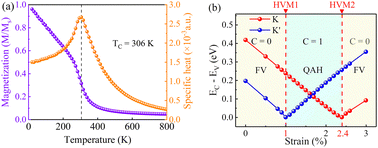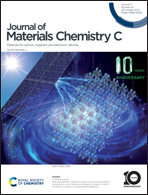Ferrovalley and topological phase transition behavior in monolayer Ru(OH)2†
Abstract
Ferrovalley (FV) materials with outstanding physical properties have garnered significant attention for their potential to revolutionize next-generation electronic devices. Through first-principles calculations, the present study has predicted and identified monolayer Ru(OH)2 as a promising FV material, which exhibits a large valley polarization of 201 meV and a Curie temperature of up to 306 K. A particularly intriguing aspect of Ru(OH)2 monolayer is its response to biaxial strain, which leads to fascinating phase transition behavior. Within a range of strains from −3% to 1%, monolayer Ru(OH)2 maintains its distinctive FV characteristics. However, at a critical tensile strain of 1%, it undergoes a transformation into a half-valley-metal state, showing unique electronic properties. As the strain is further increased, monolayer Ru(OH)2 manifests a quantum anomalous Hall effect behavior, presenting a topological bandgap of 36 meV. This could surpass the thermal fluctuation at room temperature, thus opening up exciting possibilities for future applications in electronics. Surprisingly, at a critical tensile strain of 2.4%, monolayer Ru(OH)2 reverts to a half-valley-metal state, and beyond this point, it returns to the FV semiconductor state. The unique properties and versatile phase transitions of monolayer Ru(OH)2 hold great promise for the development of cutting-edge valleytronic devices.

- This article is part of the themed collection: 2023 Journal of Materials Chemistry C HOT Papers


 Please wait while we load your content...
Please wait while we load your content...